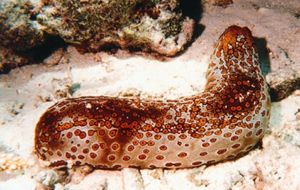MercoPress. South Atlantic News Agency
FAO report says over-fishing putting sea cucumbers at risk

Sea cucumber stocks are under intense fishing pressure throughout the world according to a new FAO report. Most high value commercial species have been depleted in the African and Indian ocean regions.
Across Asia sea cucumbers have long been a staple in peoples' diets, mainly in soups, stews and stir-fries, and demand for this homely undersea animal, echinoderms, is high.
Countries like Indonesia, Papua New Guinea and the Philippines export large quantities of them to China and other Asian markets each year and that is why sea cucumber populations across the globe, from Asia to the Galapagos, are increasingly in trouble.
“The fast pace of development of sea cucumber fisheries to supply growing international demand is placing most fisheries and many sea cucumber species at risk,” according to the study ”Sea cucumbers: a global review of fisheries and trade”.
Sea cucumber management plans specific to local circumstances need to be developed, it says. These could include such measures as establishing catch quotas and minimum size limits, closures during breeding seasons, and better monitoring of the status of stocks.
Sea cucumbers make a substantial contribution to the economies of coastal communities, being in some places the most economically important fishery and non-finfish export — highlighting the need to improve management and fishing practices.
But effective management plans for sea cucumber fisheries are uncommon, making it difficult to limit over-fishing, FAO report says.
It also identifies additional threats for sea cucumber populations worldwide, including global warming, habitat destruction, and illegal fishing.
Asia and the Pacific are the top sea cucumber producing regions, with total regional production running between 20.000 and 40.000 tons per year.
However, Ecuador's Galapagos Islands, the Seychelles in the Indian Ocean, and Newfoundland in Canada are also hotspots for production.
In a complicated process of boiling and smoke-drying, the skin of sea cucumbers, also known by the more dulcet French sobriquet bêche-de-mer, is dried for preservation purposes and later re-hydrated for use in cooking.
In Malaysia, they're called trepang, in Japan, namako, and in the Philippines, balatan. The Chinese poach the sea cukes, smother them in a thick sauce of garlic, ginger, onion and soy sauce and call them hai sum.
Aside from their use in cooking, there's also an emerging market for the use of sea cucumbers in the pharmaceutical, nutri-pharmaceutical and cosmetic industries.
Sometimes, internal organs such as gonads and intestines are fermented or dried to produce high priced specialty products used as dietary supplements.




Top Comments
Disclaimer & comment rulesCommenting for this story is now closed.
If you have a Facebook account, become a fan and comment on our Facebook Page!